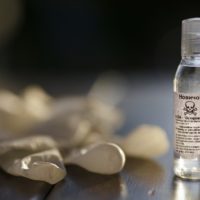
WoodyAlec/iStockBy PATRICK REEVELL, ABC News
(MOSCOW) — Novichok is a series of nerve agent weapons developed as part of a secret Soviet program and continued once the Soviet Union collapsed.
A Novichok nerve agent was used to poison the former Russian double agent Sergey Skripal in the English town of Salisbury in 2018, making the weapon a household name. So when Germany’s government announced Wednesday the Russian opposition leader Alexey Navalny had been poisoned with a nerve agent from the “Novichok group” it was seen as an explosive development solidifying evidence that Navalny’s poisoning was carried out by Russian security agencies.
Russia’s government has always denied the “Novichok” weapons’ existence, despite its own state media running interviews with the scientists involved in their creation. Most of what is known about them comes from accounts from a handful of Russian scientists, in particular Zil Mirzayanov, who in the 1990s went public about them giving interviews to Russian and foreign journalists.
“Novichok” translates as “New boy” from Russian and the name was given because the nerve agents were a new type known as “binaries.” Unlike more common nerve agents such as VX and sarin, binaries consist of two substances that have to be combined in order to activate them, making it easier to transport them and also to conceal from weapons inspectors.
The weapons were developed under a program known as “Foliant,” according to Mirzayanov. In the 1990s, he had been tasked with ensuring the secrecy of Russia’s chemical weapons program, but he decided to go public because he believed the program violated the country’s commitment to the Chemical Weapons Convention that it had signed along with the United States.
Accounts from scientists involved in creating the Novichok nerve agents have described them as extraordinarily dangerous, a tiny amount of which is enough to cause serious long-term health problems and if not treated with an antidote, death.
Andrei Zheleznyakov, a scientist working on a Novichok nerve agent described being accidentally exposed in a lab in 1987, in an interview from a Soviet newspaper found by The Guardian in 2018.
In the interview with the newspaper Novoye Vremya, he said a malfunction with hood ventilation released a small amount of the nerve agent, known as “Novichok-5” into the air. Zheleznyakov, who was given an antidote, died within a year suffering from cirrhosis, toxic hepatitis, nerve damage and epilepsy.
The nerve agents are made from organophosphates, the basis of which can be relatively common fertilizers. The agents harm victims in the same way as most nerve agents: by attacking the nervous system, causing a person to lose control of bodily functions, prompting cardiac arrest and shutting down the respiratory system.
“The ones that we know about are working very much the same way as other nerve agents such VX, sarin. So they affect the ability of the body to communicate with itself and slowly strangle it with a lack of oxygen and you end up with a cardiac arrest or a pulmonary arrest — you go into a heart attack and you can’t breathe anymore,” Gwynn Winfield, a chemical weapons expert with the publication CBRNe World, told ABC News after the Skripal poisoning.
In an academic article published in 1995 by the Stimson Center, Mirzayanov wrote that Novichok-5 was five to eight times more lethal than VX gas.
The German government suggested that the nerve agent used to poison Navalny may be somewhat different than the one used against Skripal.
Some experts have wondered why no one else around Navalny was sickened by the poison. In the Salisbury poisoning, not only Skripal’s daughter Yulia but also a responding police officer and a local couple who found the container carrying the poison were hospitalised. One of the couple, Dawn Sturgess, died.
In the case of the Skripals, British police said the nerve agent had been brought into the U.K. in a perfume bottle by two agents from Russia’s military intelligence agency, the GRU, and had been sprayed on the door handle of Sergey Skripal’s house in Salisbury. He and his daughter had likely then absorbed the poison through their skin. Mirzayanov though has said Novichok nerve agents can also take the form of powder and can be released through the air.
The Skripals spent weeks in the hospital and remain under British government protection. Navalny has been in an induced coma for almost three weeks and is still connected to a ventilator in the intensive care unit, according to Berlin’s the Charité hospital where he was evacuated from Russia at the demand of his family.
Most chemical weapons experts have said only a handful of government labs in the world could produce a Novichok nerve agent and its use would strongly suggest Russia’s state must have been involved in Navalny’s poisoning.
Germany’s chancellor on Wednesday said Russia must provide an explanation of its position around the case and said depending on the Russian response Germany and its allies in NATO and the European Union would reply with an “adequate response”.
It raises “very serious questions,” German Chancellor Angela Merkel told reporters on Wednesday. “Which only the Russian government can and must answer.”
Copyright © 2020, ABC Audio. All rights reserved.














